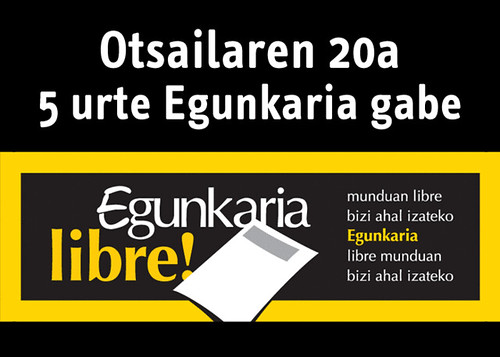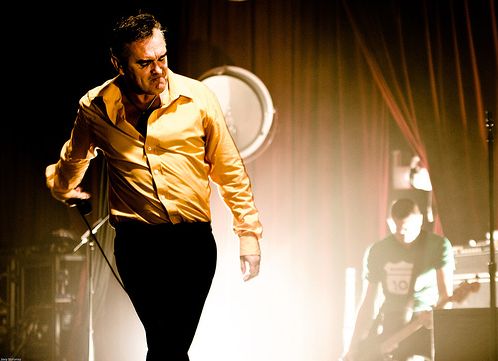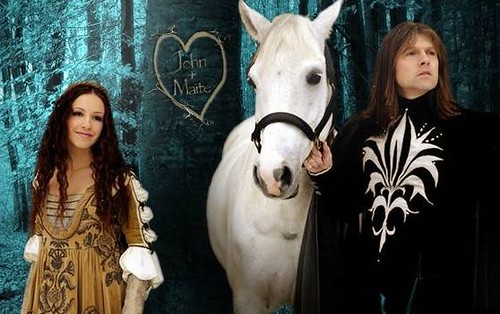English-language version of Luistxo Fernandez's blog
Five years since they closed Egunkaria
Today, it's five years since the Spanish authorities closed Egunkaria, the 1st continuous Basque language newspaper of history. I've begun a Spanish-language blog about Egunkaria.

The coastal town that they forgot to bomb
Donostia, this city I live, is a very provincian town, although some authorities think it's New York. Let's face it, it's not. However, there are some nice and somehow isolated spots of non-conformism in the social and cultural landscape of the city. Giorgio Bassmatti is one of them. One of the many incarnations of blogger Love of 74, Giorgio is a sui-generis musician, very able to compose an instant ode to the guy that made french bank Societe Generale lose zillions of euros.
There was a small concert by Giorgio near home the other day. It was in the branch offices of a bank! You see, good taste sometimes has to find refuge in the most unexpected places.
Giorgio began with one of my favorites. Morrissey. He chose Everyday is like sunday. So fitting words: This is the coastal town that they forgot to bomb, come, come, nuclear bomb... Everyday is like sunday, everyday is silent and grey. I would have suggested another song as well, Sheakespeare's sister, for its poignant lyrics: I thought that if you had an acoustic guitar that it meant that you were a protest singer ;-)

Another isolated spot of local excellence: Flickr user Yosigo. He's printed some of his works for a local exposition that opens today.

If there needs to be some Basque style definition, I wish it were more in the line of Yosigo than the Kelly Family kitsch. Pseudo-spamming chain-letters are crossing among Basque mailboxes these days referring to some Kelly familiy videos where they're signing in Basque. It seems that Maite Itoiz, one of the members of the extended family, is Basque. Anyway, look at their site and looks.

That horse lacks a horn, doesn't it?
Bring Robert Capa's lost Spanish War photos to the web
Robert Capa's lost negatives have finally come to an institution, the ICP. Great report by the New York Times, including a pic of one of the cases full of negatives, complete with its numbered tags. Among those tags, my hometown Eibar (see how it ended after the war), Bilbao, Dolores Ibarruri Pasionaria...
The mention about Amorebieta close to a campaign mass makes me suspect that these particular photos are not by Capa himself, but by David Chim Seymour. That's how ICP itself describes Seymour's work in the Spanish Civil War: (...) Basque soldiers enjoying moral support from monks at the Monastery of Amorabita (sic) and attending an outdoor mass before going into battle. The Basque chaplain pictured by Seymour, that must be it.
Anyway, I hope the ICP follows into the steps of the Library of Congress and its usage of Flickr to document thousands of pictures. How will they tag and identify all the Capa negatives in ICP's Manhattan headquartes? Bring them all to the Internet! There's people alive around that suffered the Spanish Civil War in those scenarios. My father was in Elgeta, Eibar, and other places around that front, in the same republican side of the photographers. I can sit him in front of the screen and we'll tag the pictures gladly.
Military cemeteries
I've updated the image of the Cemetery. The Plone CSS templates are too complicated for me, so I've put just a header image. Two different headers, really, for the Basque and English versions. Those cemeteries are not English, really. They are military burial grounds that we visited last summer in Normandy. The one in the Basque side is the American cemetery of Normandy, in Omaha Beach, and this one at the English side is the nearby German cemetery of La Combe, an image that a co-worker, photographer and designer Zaloa Etxaniz adapted for the header.
The title line of this blog refers to the English Cemetery of Donostia, the city in which I live. Donostia is a bilingual city, and has this English spot on it, a nice little historic cemetery for some forgotten war heroes of the 18th century. When my blog launched, this was a trilingual experiment, so I thought the English Cemetery was a fitting metaphore for it. Then El Cementerio de los Ingleses, the Spanish version, migrated to another site, the Mapamovil.

The original blog was orange, it had an image with the map location of the English Cemetery. Then in 2006 I changed to a black and white design, with some misterious girls in the header: some friends told me that header made me look like a pervert. Who cares? Anyway, now I finally show cemeteries.
Blog compliance: bilingualism, Plone, the OLPC XO, reply titles

Click to enlarge, and you'll see the Plone editing options tabs there. Visualization was fine, and all worked perfectly.
You cannot buy these in Europe, but Igor got his thru a family connection in Idaho. There was a very sensible campaign back in November and December, where you bought 2 of these, and got one, the other going to a child in the Third World.
Basque California bike made in Cambodia
No competition at home as in the website of Pamplona: Olentzero came, and the Three Kings came as well. These three types brought a pink California model of the BH brand to my daughter Lili. Hey, that bike brand is from my hometown Eibar, I said. But upon careful inspection, I realized that, as expected, it was made far away: in Cambodia, to be precise.
There was a time in which several bike brands were produced in Eibar. BH (Beistegui Hermanos, the Beistegi Brothers), GAC (Garate, Anitua and Co.), Abelux, Orbea... Now none of these factories is in Eibar any more, and of those that remain active in the Basque Country, they probably assemble or import Asian goods, more than anything else.
BH was one of the first employers of my father. In the early 1940s, he worked there. They didn't make bicycles then, but bombs. There was a market, clearly. From my dad's bedroom, he can still see the old factory, with the old symbol of BH (recently painted) in a wall that faces home directly.

That's what is left of BH in Eibar. A sign. More or less what's left in the actual bikes, the BH sign is not even metal, just a sticker added to the Cambodian product.
Asia is big. They also produce terrific cinema. Danger, Lust, from Ang Lee. More sexual than Brokeback Mountain (particularly, more heterosexual, I may add), a must-see.
Sad Christmas carol (anyway, wishing you all a happy new year)
Imagine the town council of Mobile, Alabama, publishes a web poll in its official website, asking How will you spen the next days? and the options for replying are:
- Christian Christmas
- Hanukkah
- Kwanzaa
- We're atheists, but we enjoy family life watching old Carl Sagan videos.
And then, let's imagine that people come and vote and atheists are winning by an astonishing 85%! Someone reacts in the town council and the poll and its results disappear from the web, due to some technical fixes that must be done.
Well, this Christmas carol actually happened here in the Basque Country. There is some sort of ethnic divide regarding Christmas. For the Spanish, it's the Three Kings that bring the presents. For Basques,
an indigenous figure, Olentzero, a bearded coalmaker from the mountains. There's also Papa Noel, called in the French way, also known as Santa Claus (well, there are also Basque traditions around San Nikolas but that's another story), more marginal in its appeal.
And the town council of Iruñea (Pamplona, the city of the running of the bulls) put a poll on its website, asking for preferences:
- The Kings
- Olentzero
- Santa
Then the results come...

And the radical rightwing Spanish ruling party in the city takes the poll down from the website. Well, we had saved our screenshots, just in case. There's more than that on the issue, cause in the last years the civic
processions of Olentzero coming from the mountains have been banned in Iruñea: fines of several thousand euros have been put to the civil groups that organise them. Olentzero is an outlaw there...
It's a sad story. 2007 has not been a good year in the Basque Country. No much room for hope for 2008, due to the political circumstances. I feel helpless about that, not much can be done personally, I'm afraid. So, let's try to leave our lives modestly, enjoy the innocence of our children, try to be happy in private, with our friends and family. These two are my happiness, Peru and Lili, and in accordance with my blog tradition of publishing the best photo of them both, this is my choice.

Happy 2008 to all. Peace. (there's also a carol sung by the whole family!)
The cemetery's migrating
Google Chart API replaces the Bloglines plumber

It seems the owners of Bloglines, Ask.com, are experimenting with Google Chart API. Those bubbles are Venn diagrams, aren't they? I'm experimenting too. Here's my trial below. Web navigation in the Basque Country by language (source: Eustat). Areas are exact, overlaps between languages just invented, only decorative.
Bloglines is so stalled since Mark Fletcher left it... He's experimenting with other things now: his own DNA (something that interests me as well, btw)
Places where it's hip to be square
Well, fortunately, not all foreign accounts about modern Basque living in the international media are so negative. Commonly, it's more about the marvels of Guggenheim (in the New York Times, last september), or delightful gastronomy (just past week in the NYT, again).
My favourite one, however, was written for Slate in 2003. Adventures in Basqueland by June Thomas was a nice piece of reporting, I think. June wrote about what she found amusing, and did so in a descriptive but personal way. This lovely paragraph, for instance:
Every day, groups performing styles of traditional regional music known as trikitrixa, alboka, and gaita tour the original seven streets of the Casco Viejo. Although some, especially the choral groups, tend to be dominated by graybeards, others are composed of twentysomething scenesters. Here and in the dances of the Basque Country performed every evening in the Plaza Nueva, I was shocked by how hip the artists were. Several of the young women playing medieval music on authentic instruments or dancing a jota had facial piercings; the guys with bells tied round their knees doing the sword dance while wearing big goofy red berets were cool kids with tattoos and novelty sideburns. In the Basque Country these days, it seems, it's hip to be square.
It's also amusing for us finding that what we might consider standard amuses the foreigner...



